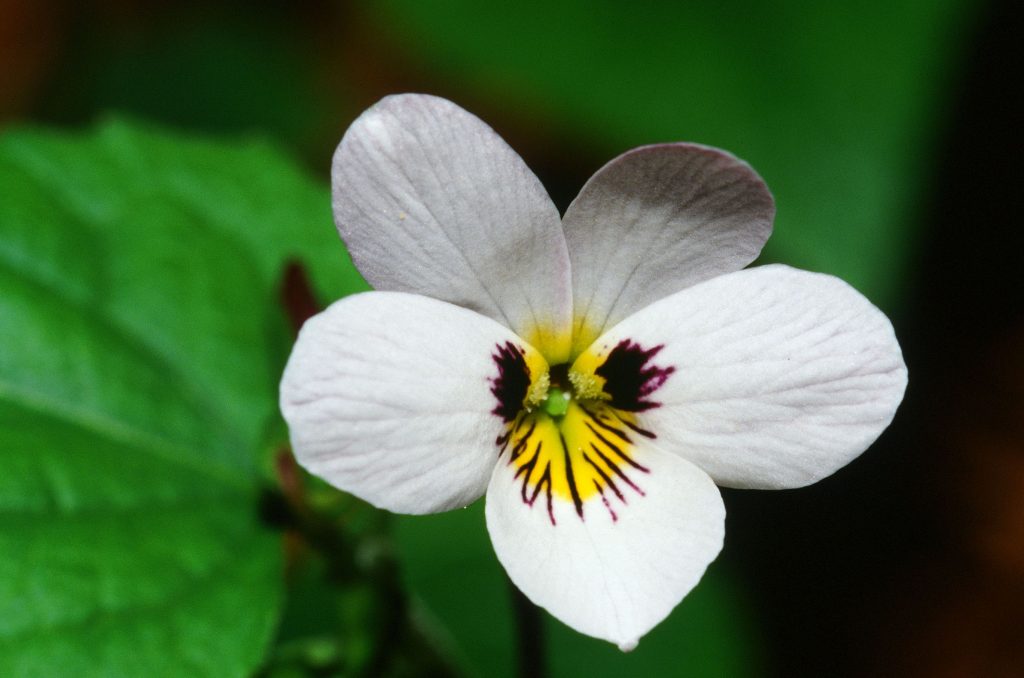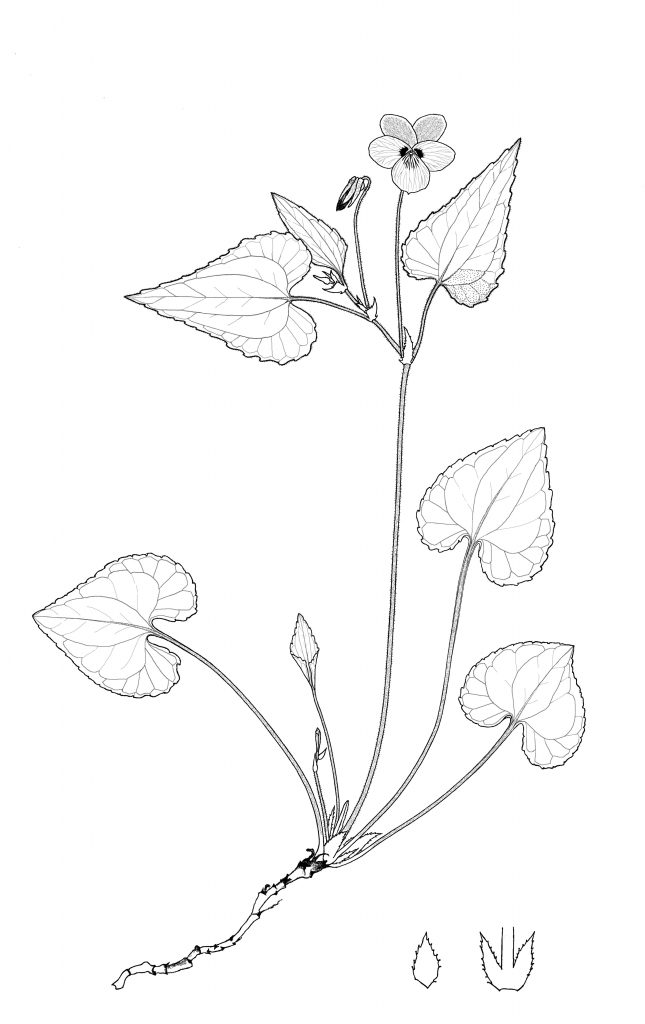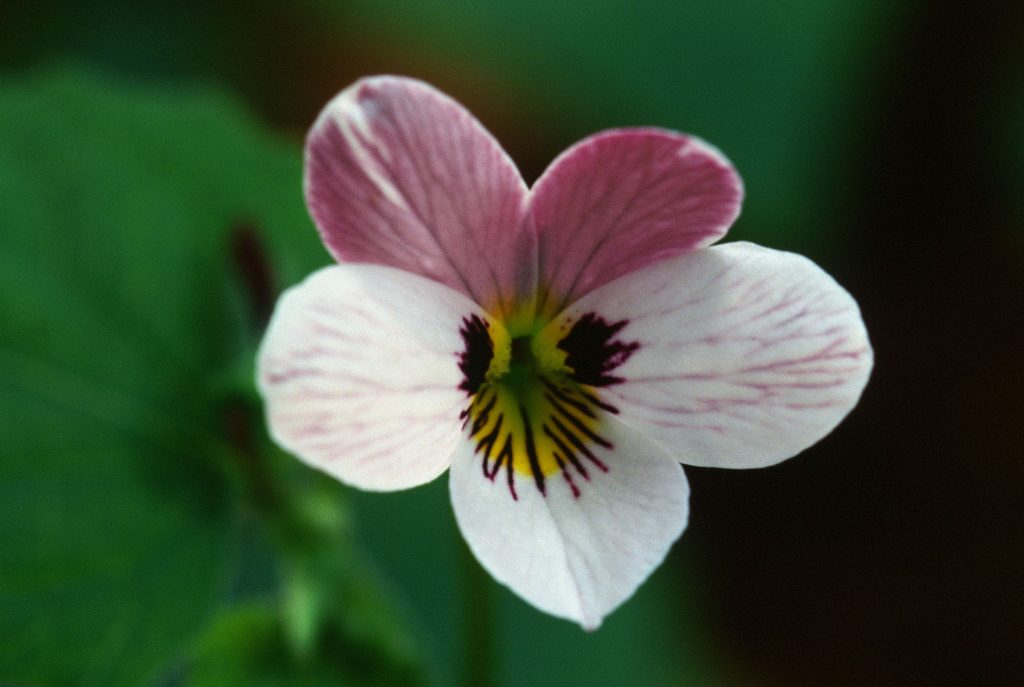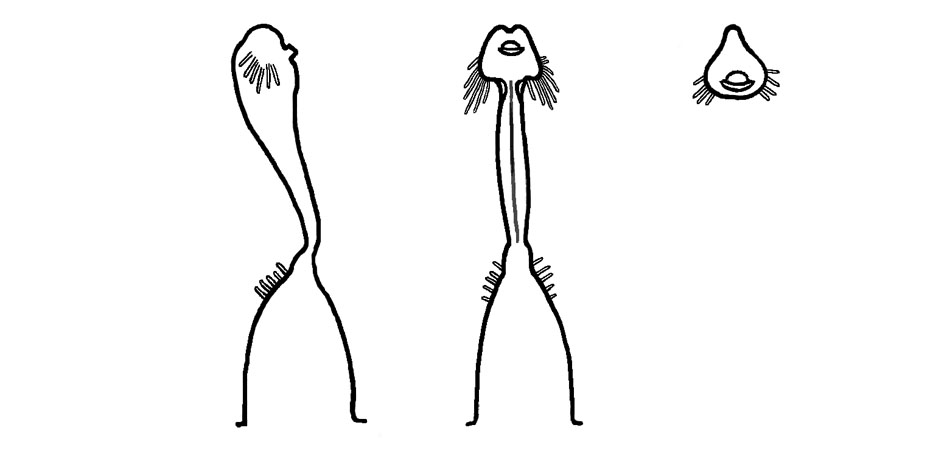Viola ocellata, Torr. & A. Gray
Description. Illustrations: 3 photographs of Viola ocellata and 3 drawings.

Viola ocellata is an attractive white-flowered violet species from the redwood belt in the Coast Ranges of northwestern California and southwestern Oregon. Its new heart-shaped leaves appear after the arrival of the late autumn rains, growing through the relatively warm wet winters to flower in early spring. The plants die down at the start of the dry summer months, their leaves turning a beautiful dark red colour, then will shoot up again with the autumn rains. This species can spread profusely when growing in its narrowly specific locations. ‘Ocellata’ means ‘marked with two-colored spots or eyes’. It is closely related to V. cuneata and V. flettii.
The violet plants are usually covered with soft spreading hairs. Elongated rhizomes spread through sandy well-drained soil and deep leaf litter; anchored by coarse fibrous roots. One to several erect stems emerge, reaching up to 30 cm, their leaves clustered at the top of the stem, well above the basal leaves. The petiole, peduncle, stem and leaf-vein colour ranges from green to a dark purple, the latter similar to the closely related V. flettii. Seed pods with recurved sepals closely resemble those of V. canadensis.
All leaves have a rugose (raised and wrinkled between the veins), glossy, dark green surface, with an acute tip and a crenate margin. The venation is relatively obscure compared with V. cuneata where it is prominent. Leaves are usually pubescent on their top surface and veins but on the lower leaf the hairs are harder to see as they lie flat on the surface. Its basal leaves are larger and heart-shaped with deeply cordate leaf bases, their petioles being longer than the leaves, but shorter than the aerial stems. The smaller upper stem leaves are cordate-ovate to long-triangular or rhomboid; at the base shallowly cordate, truncate to attenuate also with an attenuate tip. The short petioles of the stem leaves are subtended by free lanceolate stipules while those of the basal leaves are partly adnate to the petiole and become brown-scarious with age. Stipules are ciliate and fimbriate on their margins.

Axillary flower peduncles of 2-4 cm long are about equal in length to the leaves, glabrous or pubescent; green braceoles on the upper peduncles are 0.2 cm long. Largely white flowers appear from March to June, flowers 10-15 mm long, with no perfume. Petals are white with yellow near the base to form a yellow centre, the laterals petals have a dark purple spot near the base, and a yellow beard of short club-shaped to rounded hairs. These are all characteristic of members of section Canadenses. The upper two petals are deep red-purple on the reverse, this back colour showing through the thin petals to give a lavender cast. However if using flash photograpy the light is reflected back from the white front of the petals so that the purple is not obvious. The lowest petal is rounded, with purple guidelines and a small point at the end. The bright green style head is notched at the top, with hairs on the back of the head; the petal spur is pale green, saccate, 1.5 mm long x 2.5 mm wide. The calyx is 6-9 mm long; sepals are lanceolate, acute, with very short hairs on their hyaline margins; appendages (auricles) are rounded, green, glabrous, fat, 0.5 – 1.0 mm long.

The rounded seed pods are 6-8 mm long, green sometimes spotted with purple, minutely puberulent and with recurved sepals. Closed (cleistogamous) seed pods are borne from the upper leaf axils later in the early summer. Seeds large dark brown-black, 2.5-2.7 x 1.5-1.9 mm.
The habitat of this species is cool shaded woodland, in very deep leaf litter, over gritty, well-drained soil, especially on slopes along rivers and streams. In forests of redwoods (Sequoia sempervirens) and mixed evergreens [Quercus kelloggii (black oak), Libocedrus decurrens (incense cedar), Pinus ponderosa (yellow pine), Pinus jeffreyi (Jeffrey pine), Arbutus menziesii (madrone)] are damp from fog and rains during winter to spring, then dry out in summer. It is often in areas that have been selectively logged. It also has a strong affinity to serpentine soil. In the Coast Ranges the soil is made up of sandy mud and black shale scraped off the seafloor onto the edge of the continental plate as the heavier basalt larva sinks under the west coast of North America. These rocks always contain chromium and platinum plus gold.
Viola ocellata is endemic to north and central western California, in the Coast Ranges from Monterey County to Del Norte, Trinity and Shasta Cos. and into northern Douglas Co. of south western Oregon. Elevation 150–1100 m.

Nomenclature and Taxonomy:
V. ocellata Torr. & A. Gray, Fl. N. Amer. (Torr. & A. Gray) 1: 142. 1838.
Section Chamaemelanium Becker, subsection Canadenses (Marcussen, 2011).
First collected by David Douglas in California.
2n=2x=12. Diploid. Base chromosome number x=6.

